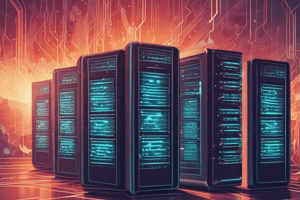Podcast
Questions and Answers
Which type of computer system is designed for portable users?
Which type of computer system is designed for portable users?
- Personal
- Mobile User (correct)
- SOHO
- Power
What does SOHO stand for?
What does SOHO stand for?
Single Office/Home Office
Which of the following describes data?
Which of the following describes data?
- Unprocessed facts (correct)
- Organized facts
- Skills acquired through experience
- Processed information
What does GIGO stand for?
What does GIGO stand for?
What is the primary function of a cpu?
What is the primary function of a cpu?
The process of _____ involves analyzing and processing the instructions given to a device.
The process of _____ involves analyzing and processing the instructions given to a device.
The keyboard is considered an output device.
The keyboard is considered an output device.
What is HDMI primarily used for?
What is HDMI primarily used for?
What is the primary advantage of using a keyboard?
What is the primary advantage of using a keyboard?
Which of the following is NOT a component of the information processing cycle?
Which of the following is NOT a component of the information processing cycle?
Study Notes
Types of Computer Systems
- Personal Computers: Versatile, affordable, utilize basic input/output devices.
- SOHO (Single Office/Home Office): Computers and printers connected in a network for small businesses or home offices.
- Mobile Devices: Designed for portability, including tablets, phablets, smartphones, and laptops.
- Power Computers: High-performance systems with advanced specifications, requiring more RAM, CPU power, and storage, resulting in a higher price.
- Enterprise Systems: Used by businesses with numerous users across various locations, relying on extensive networks for connectivity.
Information Management
- Data: Unprocessed facts, lacking organization or meaning.
- Information: Meaningful knowledge derived from organizing and processing data.
- Knowledge: Facts, information, and skills acquired through experience or education.
- Conclusion: Formation of judgments based on knowledge acquired from information.
Reasons for Using Computers
- Productivity:
- Paper Savings: Electronic data transmission eliminates paper usage.
- Time Savings: Faster information creation and delivery processes.
- Labor Savings: Computers can perform complex calculations and tasks 24/7, reducing human effort.
- Cost Savings: Communication methods like VoIP, email, and instant messaging are more cost-effective than traditional phone calls.
- Efficiency, Accuracy & Reliability:
- GIGO (Garbage In Garbage Out): Inaccurate input results in inaccurate output.
- Data Validation: Computers provide efficient and accurate data input methods.
- Global Communication:
- Distance: Instant communication worldwide regardless of location.
- Time: Real-time communication without delays.
- Social Networking: Connecting with individuals worldwide using platforms like Facebook, Twitter, and Instagram.
- Web Tools:
- Blogs/Vlogs: Online diaries.
- Wikis: Collaborative platforms allowing content creation, editing, and removal from web pages.
- RSS Feeds: Consolidation of updates from various sources (blogs, websites) into a central location (email).
- Web 2.0: Facilitates user collaboration and information sharing.
- Convergence: Combining multiple technologies to create innovative products.
Hardware
Information Processing Cycle
- Input: Instructions given to the device
- Devices: Mouse, touch screen, keyboard, microphone, camera, scanner.
- Processing: Analyzing and processing instructions.
- Devices: CPU, RAM, ROM, graphics card.
- Output: Displaying results of processing.
- Devices: Monitor, printer, speaker, projector, earphones.
- Storage: Saving information for future use.
- Devices: Hard drive, flash drive, CD/DVD, memory card, USB hub.
- Communication: Sharing results with others.
- Devices: Modem, router, switch, NIC, cables.
- Multi-touch Screen: Allowing registration of multiple touch points simultaneously.
- HDMI: High-definition multimedia interface for connecting high-resolution video devices, eliminating separate audio cables.
- 3D Printing: Creating three-dimensional objects from digital models by successively layering material.
Input Devices
Keyboard
- Advantages: Simple information input (minimal training required), fast data entry.
- Disadvantages: Difficulty for disabled users, potential for typing errors.
Studying That Suits You
Use AI to generate personalized quizzes and flashcards to suit your learning preferences.
Related Documents
Description
Explore the various types of computer systems from personal to enterprise, along with their defining characteristics. Additionally, delve into the concepts of data, information, and knowledge to understand how they interact in the realm of information management.




